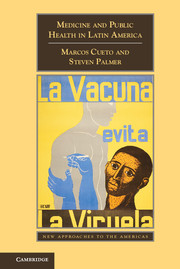Book contents
- Frontmatter
- Contents
- Acknowledgments
- Introduction
- Chapter One Indigenous Medicine, Official Health, Medical Pluralism
- Chapter Two National Medicines and Sanitarian States
- Chapter Three Making National and International Health
- Chapter Four Medical Innovation in the Twentieth Century
- Chapter Five Primary Health Care, Neoliberal Response, and Global Health in Latin America
- Conclusion
- Suggested Readings
- Index
- References
Chapter Five - Primary Health Care, Neoliberal Response, and Global Health in Latin America
Published online by Cambridge University Press: 05 December 2014
- Frontmatter
- Contents
- Acknowledgments
- Introduction
- Chapter One Indigenous Medicine, Official Health, Medical Pluralism
- Chapter Two National Medicines and Sanitarian States
- Chapter Three Making National and International Health
- Chapter Four Medical Innovation in the Twentieth Century
- Chapter Five Primary Health Care, Neoliberal Response, and Global Health in Latin America
- Conclusion
- Suggested Readings
- Index
- References
Summary
Two processes above all others have inflected health and medicine in Latin American over the last forty years. One was the proposal of primary health care (PHC) as a comprehensive approach to reorient and emphasize preventive health services for the entire population of the region, especially those on the urban and rural margins, and to involve them in the promotion of their own health. Several cases of health in adversity in the late twentieth and early twenty-first century can be understood in terms of efforts to embrace PHC. Similar to experiences going on around the developing world, the approach was eventually codified at a crucial 1978 meeting of international health delegates in Alma-Ata (a city in Kazakhstan now known as Almaty), whose final declaration famously called for the implementation of PHC in order to achieve “health for all by the year 2000.” While PHC did not emerge from Latin America, and many experts consider that it has yet to be fully implemented there, many partial and national programs in the region anticipated the global consensus reached at Alma-Ata. The continent’s most ambitious primary health care–based systems offer the promise of health services to all members of society and the integration of popular medicine, biomedicine, rehabilitation programs, and preventive medicine into a dynamic health system. Though the degree to which Cuba actually achieved this is hotly debated, its embrace of such integral medicine was able to elevate the tiny island nation into something of a world medical power, achieving developed-world health indicators for its population while exporting tens of thousands of trained health professionals to areas of the world in need of expanded primary care.
The radical, populist tinge of the comprehensive approach to PHC signed off on at Alma-Ata was quickly challenged by advocates of measurable, cost-effective, selective primary care interventions. These more conservative proposals were promoted and adopted by major bilateral and multilateral players in the context of the end of the Cold War and the rise of a neoliberal consensus that states should remove themselves as much as possible from providing or expanding social services. The ultimate logic of this consensus was that the state should cease to operate many programs and manage the health arena in a way that would give space to private providers. The assumption was that competition would make services more efficient and provide the public of public health, now reconceived as a group of individual patients, more choice. The more extreme versions of neoliberal health policies conceive state medicine and public health as part of a culture of survival of the poor.
- Type
- Chapter
- Information
- Medicine and Public Health in Latin AmericaA History, pp. 204 - 258Publisher: Cambridge University PressPrint publication year: 2014

